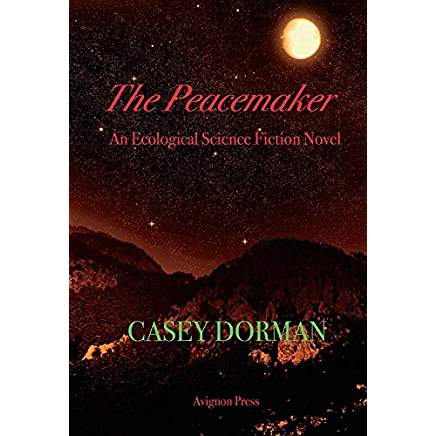
Values and Science Fiction
In her book, Science Fiction and Philosophy, Susan Schneider describes the best science fiction novels as “long versions of philosophical thought experiments.” Aldous Huxley, Ursula Le Guin, Philip K. Dick, Arthur C. Clarke, and Kim Stanley Robinson are prime examples of some of the genre’s finest, whose novels not only raise philosophical issues, but reflect their author’s values.
The best philosophical science fiction reflects its author’s beliefs, but because it is science fiction, those beliefs need to be buttressed with real science, all of it turned into entertaining, imaginative speculation. That goal guided my writing in my most philosophical novel, The Peacemaker.
What if the world had progressed to a point that it was no longer livable for human beings? The climate has warmed, the seas have risen and covered all low-lying areas of the world, air pollution makes the air toxic. It’s too late to turn back the clock and save the planet. What can mankind do? Stephen Hawking examined this scenario and declared, “We must use our curiosity and intelligence to look to the stars.” He recommended that the human race migrate to a planet within the habitable zone surrounding a nearby star.
Kim Stanley Robinson, one of the best at including real science and values in his novels, has examined the migration theme in several of his novels. His classic, Mars Trilogy examines the underlying values that determine whether it is worth transforming (terraforming) the red planet to be livable, like earth. In Aurora, he describes transporting a group of more than two thousand people from an environmentally degraded earth to a distant planet to set up a new society, a trip that takes 160 years and ultimately fails. In his more recent, 2312, the population has left a climate-change devastated earth, and lives within terraformed asteroids (called “terrariums”), in a moveable city on Mercury, and on a moon of Jupiter. As in Aurora, the population finally returns to try to rejuvenate earth, centuries after leaving. Robinson’s novels represent a wide-ranging exploration of Stephen Hawking’s notion of migrating from earth, and, in Robinson’s view, expose its limitations, if not the futility. I’m waiting with bated breath for Robinson’s new novel, The Ministry for the Future, coming out in October of this year, which also deals with climate change, and describes the ways in which efforts to avert further climate change may play out.
For me, combating climate change and protecting our environment and the other species with whom we share the planet is a primary value, as are living nonviolently and avoiding war and achieving social justice and equality. My novel, The Peacemaker deals with all of these issues.
In constructing The Peacemaker, I was influenced by three writers: Ernest Callenbach, whose 1974 novel, Ecotopia, provides a blueprint for forming a society that allows man to live within nature without destroying it. Arne Naess, Norwegian philosopher and environmental activist, who developed the Deep Ecology movement, based on valuing the existence of all living creatures, limiting population and industrialization, and living by nonviolent, democratic principles. Janine Benyus, who pioneered Biomimicry, which promotes copying nature’s solutions in order to live compatibly with our environment.
The story takes place on twin planets, one of which, a thousand years previously, had heated its climate and oceans and ruined its natural environment to the extent that its population needed to move to the other, heretofore uninhabited twin planet. One race of people, who served as slaves to the others, were left behind. A thousand years later, the second planet’s environment has been ravaged and its inhabitants decide to move back to their original home, which, under the guidance of the race left behind, has thrived and rejuvenated its natural environment. Those who reside on the original planet resist the “invaders” who want to reinstall their old society and refuse to abide by any of the new rules for preserving the environment. A war seems imminent. Into this situation steps “the peacemaker” a mysterious, empathic, and charismatic representative of a more advanced civilization whose role is to prevent interplanetary wars. The science underlying the book is related to the descriptions of living within a Deep Ecology framework and employing Biomimicry as the major form of technology. The empathic nature of the main character is based on real neuroscience, my own field of expertise. The sociology is metaphorical and includes allusions to the Bible, to slavery and bigotry based on race, and to the conflict between Israel and the Palestinians. It’s an exciting speculative piece of philosophical entertainment.
“The Peacemaker is, plain and simple, a wake up call. While it takes place on distant planets in a distant galaxy, it is a window into the future of our own.” Riya Anne Polcastro, author of Left Behind, Book One
“an original contribution to utopian sci-fi,” Anca Vlasopolos, author of The New Bedford Samurai
“captures the plight of a planet brought to near extinction through abuse of its natural resources” Dean Giles
Interested? The Peacemaker is available for FREE as a Kindle book for the next 3 days, by clicking HERE
(I’ve also reduced the paperback price to $7.95, in case you’d rather have a book you can feel with your own hands).
Comments or questions? You can reach Casey Dorman by email at Share this newsletter with friends. mailto: caseylostcoast@gmail.com
If you’re not already on our mailing list and want to be, subscribe to Casey Dorman’s newsletter by clicking SUBSCRIBE.




